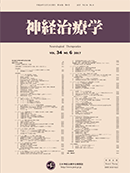35 巻, 2 号
選択された号の論文の16件中1~16を表示しています
- |<
- <
- 1
- >
- >|
-
2018 年 35 巻 2 号 p. 77
発行日: 2018年
公開日: 2018/08/31
PDF形式でダウンロード (202K)
Editorial(論説)
-
2018 年 35 巻 2 号 p. 79-82
発行日: 2018年
公開日: 2018/08/31
PDF形式でダウンロード (449K)
特集 2040年の日本社会にむけた神経内科治療
-
2018 年 35 巻 2 号 p. 83-85
発行日: 2018年
公開日: 2018/08/31
PDF形式でダウンロード (1978K) -
2018 年 35 巻 2 号 p. 86-91
発行日: 2018年
公開日: 2018/08/31
PDF形式でダウンロード (4442K) -
2018 年 35 巻 2 号 p. 92-95
発行日: 2018年
公開日: 2018/08/31
PDF形式でダウンロード (1473K) -
2018 年 35 巻 2 号 p. 96-98
発行日: 2018年
公開日: 2018/08/31
PDF形式でダウンロード (395K) -
2018 年 35 巻 2 号 p. 99-103
発行日: 2018年
公開日: 2018/08/31
PDF形式でダウンロード (471K) -
2018 年 35 巻 2 号 p. 104-107
発行日: 2018年
公開日: 2018/08/31
PDF形式でダウンロード (449K) -
2018 年 35 巻 2 号 p. 108-112
発行日: 2018年
公開日: 2018/08/31
PDF形式でダウンロード (2390K)
総説
-
2018 年 35 巻 2 号 p. 113-117
発行日: 2018年
公開日: 2018/08/31
PDF形式でダウンロード (650K)
原著
-
2018 年 35 巻 2 号 p. 118-121
発行日: 2018年
公開日: 2018/08/31
PDF形式でダウンロード (1936K) -
2018 年 35 巻 2 号 p. 122-126
発行日: 2018年
公開日: 2018/08/31
PDF形式でダウンロード (1105K)
神経治療最前線 海外学会参加報告
-
2018 年 35 巻 2 号 p. 127-128
発行日: 2018年
公開日: 2018/08/31
PDF形式でダウンロード (1277K)
-
2018 年 35 巻 2 号 p. 129-132
発行日: 2018年
公開日: 2018/08/31
PDF形式でダウンロード (381K) -
2018 年 35 巻 2 号 p. 133
発行日: 2018年
公開日: 2018/08/31
PDF形式でダウンロード (217K) -
2018 年 35 巻 2 号 p. 134
発行日: 2018年
公開日: 2018/08/31
PDF形式でダウンロード (208K)
- |<
- <
- 1
- >
- >|
